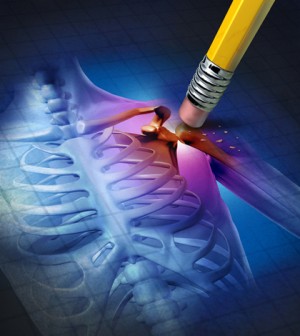Pain Clinics: What to Know
What Is a Pain Clinic?
Also called pain management clinics, they’re health care facilities that focus on the diagnosis and management of chronic pain. There are two kinds. One focuses on procedures to deal with specific types of pain, like neck and back pain.
YOU MIGHT LIKE
They also may teach you about your pain, coach you on lifestyle changes, and offer complementary or alternative medicine.
What’s the Goal?
It’s to cut your pain and raise your quality of life. Treatment at a pain clinic can give you the skills to manage your chronic pain on your own and make you more able to function, possibly so that you may return to work.
Do They Work?
Multiple studies say folks who have comprehensive pain management have less pain and emotional distress. Research says they also can do their daily tasks easier.

Tips to Help Get the Best Chronic Pain Treatment from Your Doctor
- Don’t bring any bad experiences you may have had with other doctors to your appointment. You don’t want to muddy your doctor relationship. Start with a clean slate.
- Go with a stated purpose but don’t go with any pre-conceived expectation about getting a certain treatment, like opioid therapy, or a specific diagnostic test, like an MRI. Unfortunately, there isn’t an easy answer for chronic pain. It’s not like prescribing an antibiotic to cure an infection. Most chronic pain doesn’t have a cure. You may not be able to be fixed.
- Ask your doctor about arranging recurrent appointments (quarterly, etc.) just for pain management as well as scheduling extra time, if needed, for those appointments.
- If you’re seeing the doctor about other medical conditions unrelated to your normal chronic pain, don’t talk about your chronic pain. Keep it for your regular pain visits.
- If you find you and your doctor aren’t a good match, then keep looking for another provider. Some patients have found a nurse practitioner a viable alternative to a physician. There are a variety of healthcare providers available to team with.

Stop Living With Pain
Always maintain a good posture
Maintaining a proper posture while you sit, stand or sleep is extremely important. Especially, sitting in a good posture is a good way to stay away from back and neck pain. Always sit in a neutral position while sitting on a chair. If you are suffering from chronic pain and seek to give some rest to your neck, choose a neck supporting chair. Make it a point to use a headrest wherever you sit, be it a car or a chair.
Watch your phone usage
Using the phone in the wrong manner can worsen your pain. People cause unnecessary strain on the neck is by cradling it between the ear and neck. This causes strain in the cervical spine which increases the pain level.
Opt for a therapy
There are various types of activities that help in improving chronic situations. For example, acupuncture is an effective therapy for the treatment of various physical and mental conditions. It involves inserting needles in specific areas of the body for treating diseases.
Use ice therapy
Many backs and neck pain center suggest ice therapy for pain relief, which is actually an effective technique for chronic pain.
Eat healthy food
Let food be thy medicine, thy medicine shall be thy food. The saying by Hippocrates is true for people with chronic pain. A well-balanced diet has an array of benefits. It improves blood circulation, keeps weight in control and prevents various diseases.

Tips for Chronic Pain Management
Chronic Pain Management Tip: Journal About Your Feelings
Writing out your feelings can help you cope with pain. Getting them out can release negative feelings, and re-reading your thoughts can help you better understand what you can do to make life easier moving forward. Re-reading your thoughts over time can show you the progress you’ve made and remind you of the good things you have. It can give your life meaning and help you focus on the positives.
Chronic Pain Management Tip: Maintain a Healthy Diet
Food can be very powerful in helping you combat pain. Certain foods can help you reduce inflammation to ease pain, so consider switching up your diet. Foods rich in Omega-3 fatty acids such as tuna and salmon can help those suffering from rheumatoid arthritis, while fruits contain carotenoids, which help fight inflammation at a cellular level. Try adding in some leafy green vegetables and yellow, orange and red fruits and veggies to your next meal.
Chronic Pain Management Tip: Try Alternative Medicine
Some alternative techniques to traditional medicine can have positive effects. Acupuncture, massage and chiropractic treatments have been found to help in treating pain. Studies have shown that chiropractic care can benefit patients suffering from fibromyalgia, carpal tunnel syndrome, headaches and musculoskeletal pain.
Chronic Pain Management Tip: Stay Busy with Hobbies
Distraction won’t relieve pain, but it can cause it to be less of a focus. When you’re thinking about something else, you won’t be thinking about your pain as much. Make sure your hobbies don’t cause your pain to flare up. Like exercise, make sure they are low impact; some good ones to try are knitting, crossword puzzles, playing board games, gardening and golf.
Chronic Pain Management Tip: Engage in Physical Activity
Physical activity is important when you’re battling pain. It’s one of the most effective tools in chronic pain management, although it sounds difficult to do. Regular exercise keeps your joints flexible and the muscles around your joints strong. The important thing is to do low-impact exercises to avoid exacerbating your pain level. These include swimming, walking and strength training. Also, make sure to warm up and cool down, and start slow and add on repetitions over time. And don’t forget to stay hydrated throughout your workout!

Effective Pain Management Techniques that Work
Manage Your Stress
It sounds like simple advice, but stress management is a crucial component of pain management. Stress and fatigue increase pain and make it worse. Schedule appointments, keep a daily routine, avoid stress triggers, and learn to say no to added responsibilities. By decreasing the stress in your life, you can also decrease the pain.
Meditation
To help your body relax, try deep breathing with meditation to relieve tension and tightness from your muscles. Focusing on your breathing, repeating a phrase or word (mantra), and ignoring other thoughts all cause your body to relax. With meditation, you reduce the stress that intensifies chronic pain and worsens conditions like anxiety, depression, and anger. Meditation with progressive muscle relaxation enhances the release of endorphins and serotonin, two chemicals that help with pain management.
Massage Therapy
One of the oldest pain management tips around is massage therapy. The reliance on a variety of massage techniques allows you to increase water flow and decrease swelling. Massage relieves tense muscles, promotes endorphins, and soothes aching joints. The massage therapist can use a comprehensive approach of massage techniques, such as reflexology, neuromuscular therapy, or Swedish massage.
Electrotherapy
A pain management tip fairly unknown to many is electrotherapy. The doctor or therapist uses a transcutaneous electrical nerve stimulator (TENS unit) to attempt to reduce your pain. This device produces low-voltage electric stimulation that corresponds with the sensory nervous system to reduce pain sensations.
Cutaneous Stimulation
Cutaneous stimulation involves the superficial cooling or heating of the skin. This age-old technique yields the best results when used together with exercise and other circulatory methods. Heat and cold treatments alleviate the pain and stiffness associated with arthritis and disc disorders. The cold therapy works by numbing the area and reducing inflammation, while the heat increases blood flow to the area.